Mesoamerican art represents the incredibly diverse artworks created by indigenous cultures in geographical regions that today are the countries of Mexico, Guatemala, Honduras, Belize, El Salvador, Nicaragua, and Costa Rica. These groups flourished between15,000 BCE to 1521 CE, prior to the arrival of the Europeans in the 16th century. Artists continued to produce art afterwards, but with different influences.
Notable Meso-American Artwork
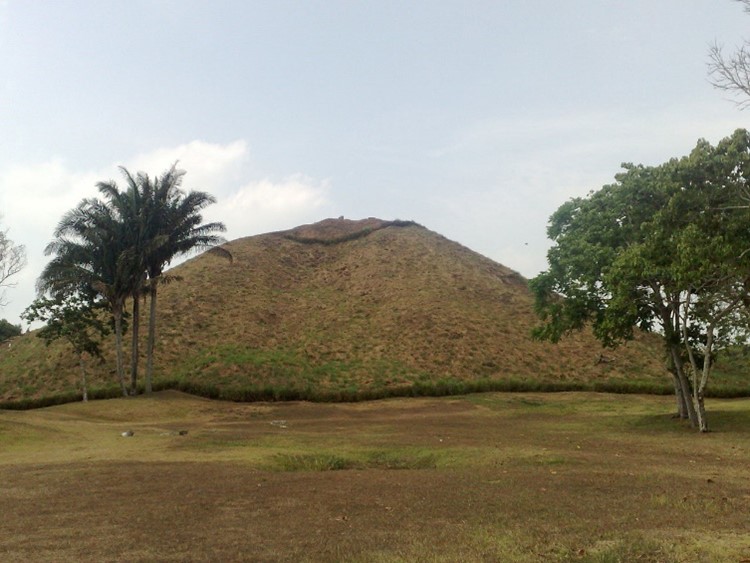
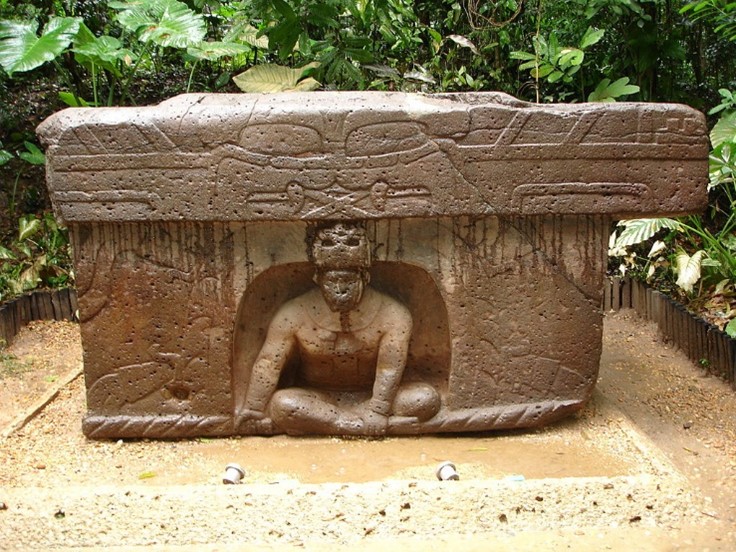
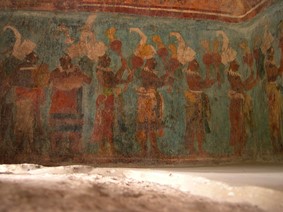
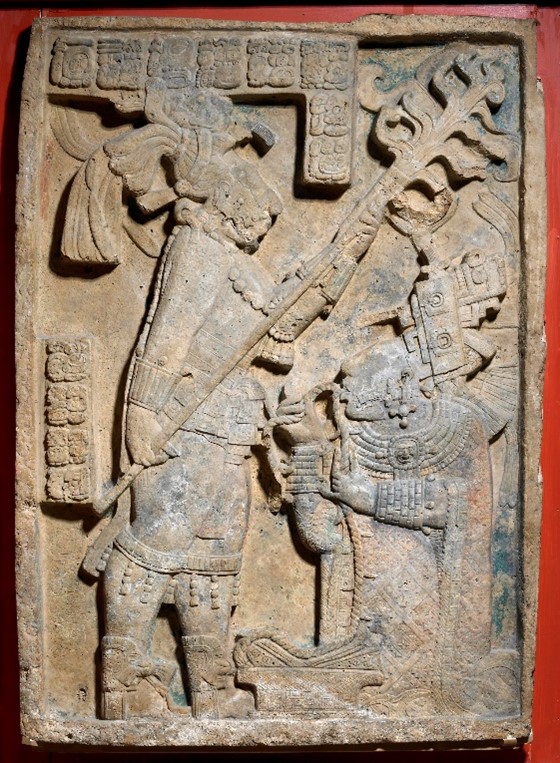
lintel | British Museum
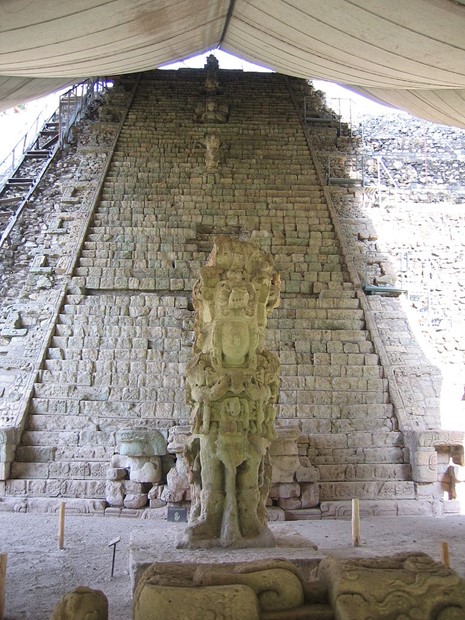
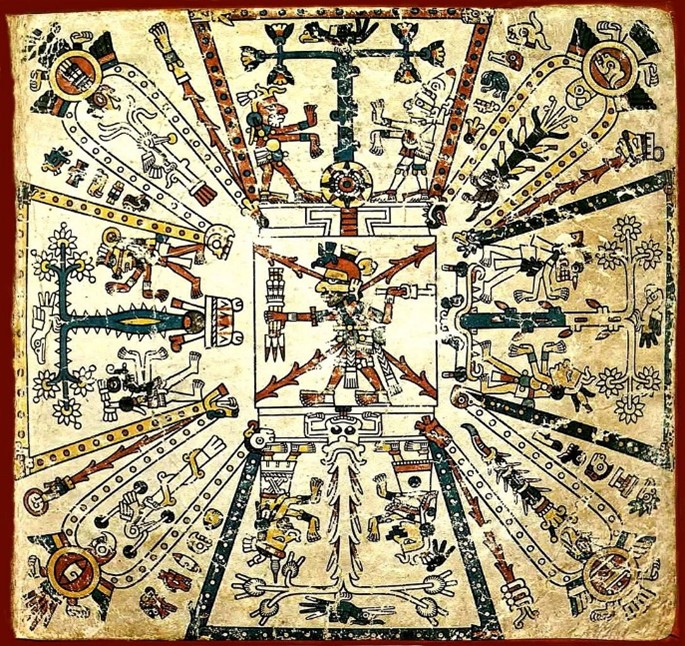
Which Cultures Make Up Mesoamerican Art?
Major cultures that are represented in Mesoamerican art included three main groups: Olmec, Maya, and Mexica or Aztec. Other indigenous cultures included Teotihuacan, Tlatilco, Zapotec, Toltec, and Mixtec.
Timelines of Mesoamerican Art
To assist with the categorization of Mesoamerican art, archeologists and art historians have established timelines.
Art and architecture that existed prior to 1492, before the arrival of Christopher Columbus, are called pre-Columbian.
Archaic Period 1400-1800 BCE
The Archaic period stretches from 1400 BCE-1800 BCE. Very little in the way of art was found from this period, but developments set the foundations for later communities. The indigenous people in Mesoamerica were hunters and gathers of plants.
Pre- Classic Period in Mesoamerican Art (1800 BCE- 150 CE)
The Pre-Classic period or Pre-Formative period began in 1800 BCE and progressed to 150 CE with art from the Olmec, Teotihuacan, Tlatilco, Maya and Zapotec. Agriculture began with crops including maize, fruits, cacao, and root crops. Pottery and later ceramics were made for cooking and storage. Towns and villages began to form and with it came the rise of hierarchies.
The Olmecs were the first pre-Columbian civilization and lived in what is now modern-day Mexico, Guatemala, Belize, and Honduras. Olmec civilization created the first pyramid, La Venta, the center of Olmec culture between 800–400 BCE . Impressive art forms included the making large-colossal heads and masks. Dietities began to appear in works, as well as primitive glyphic writing.
Mayan civilization spread over many Mexican states as well as other countries including Guatemala, Belize, El Salvador, and Western Honduras. Much of the Olmec culture was absorbed into Maya and Teotihuacán civilizations. Olmec sculptures were considered precious and were later found in gravesites of other cultures.
The Tlatilco lived on a lake in Mexico City, long before the Aztecs ruled the area. Living in huts of mud and reeds, artisans were well known for the creations of ceramics and figurines.
Classic Period in Mesoamerican Culture
The Classic period was dominated by the Maya and Teotihuacán civilization and spanned from 150-650 CE. The shared Olmec traditions began to diverge. The Maya introduced the calendar as well as hieroglyphic writing. Scholars developed both astronomy and mathematics established in written text. Architectural buildings, featuring corbelled vaulted architecture became monumental in scope with pyramids, palaces, and ball courts
Meanwhile the Teotihuacán were interested in politics and commerce. The Valley of Mexico became the center for these endeavors. This was the period of the megacity with the city of Teotihuacán becoming the sixth largest city in the world. Power diminished for the Teotihuacán around 600 CE. Various cultures within Mesoamerica fought for power.
Epiclassic Period (650-900 CE)
Without the Teotihuacán power shifted to smaller regions of Xochicalco, Cacaxtla, and El Tajin. Art here flourished with new buildings and sculptures.
Post- Classic Period (950- 1519 CE)
Toltecs ruled between 900- 1200 CE, while the Mayan civilization began to collapse. Smaller regions were now linked in trade opening opportunities for the creation of art, including both traditional and new styles. Shell jewelry and objects, as well as jade sculptures, were popular among the Toltec, Mixtec, Maya and Mexica or Aztec Mesoamerican cultures.
In Oaxaca, the Mixtec people were experts in metalwork using silver and gold. This was new to Mexico and Central America, but artists in the Andes of South America were already producing similar items. The Mixtec also crafted codices with hieroglyphics.
This was a period dominated by the Mexica or Aztec civilization in Central Mexico. The Aztec civilization had advanced irrigation systems that allowed for them to develop agricultural crops on all available land. As they grew in dominance, they incorporated the art of other regions into their work.
The Aztecs civilization dominated all tribes in Mexico at the time and were defeated during the Spanish Conquest (1519) by Cortes and his men.
Pre-Columbian to Post-Columbian
Life and art were dramatically affected with the presence of the Europeans. Indigenous people were converted to Christianity, primarily Catholicism and new art reflected this.
Common Characteristics of Mesoamerican Art
While Mesoamerican art was culturally diverse there were some similarities. This included the use of calendars, made of 260-day years, the importance of green stones, such as jadeite, and the use of bird feathers.
Painting and Sculpture
Figural representation in painting and sculpture was illustrated in most all works. These Mesoamerican art objects were used for decorative purposes, ceremonies, in gifts and burials. The mystical was also depicted from visions to transformation and the celestial heavens.
Mesoamerican Architecture
Religion played an important role prompting Mesoamerican civilizations to build pyramids, temples, and amphitheatres to honor gods, for ceremonies and rituals.
Earth mounds faced with stone were the first temple-pyramids in Mesoamerican architecture. Access to the platform or temple was via steps and reserved for the elite members of the Mesoamerican community. The location of the site was important and built in relation to sacred mountains or celestials.
Pyramids later changed forms, becoming multi-levelled, with a single or double temples. Outdoor spaces were important, and often faced with brightly painted relief sculptures.
Religion and Mesoamerican Cultures
In Mesoamerican culture multiple gods were worshipped. Some were shared, others were unique to specific groups.
A generally believed that the world was divided with a horizonal and vertical line. Where the lines intersected was called the axis mundi. Each divisional line represented north, south, east, and west. From here the celestial, terrestrial and underworld were split.

The Codex Fejérváry-Mayer is a pre-Colombian Aztec Codex of central Mexico. In the center Xiuhtecuhtli, the god of fire standing at the axis mundi. Images represent the three worldly sections.
Olmec Art
When making colossal heads, masks and ritual objects, Olmec artists chiseled from a single block of stone. The heads were commonly made from basalt. Smaller objects were carved from jade or serpentine.
La Venta, in Tabasco, Mexico, the center of Olmec culture (800–400 BCE), contains a pyramidal structure, that historians believe was once aligned to a constellation. The earth mound measures 100 feet high and volcanic in appearance. Further north numerous tombs were uncovered. Colossal heads carved of basalt and weighing 18 tons, small jade objects, stela and altars were also found.
There were seven basalt Olmec art alters. The bas-relief figure in Altar 4 is seated in what looks like the mouth of a cave, while holding a rope. Upon closer inspection eyes and fangs appear in the cornices and the figure is inside the mouth of a creature.
San Lorenzo, located in the southeast corner of Veracruz, in Mexico, developed between 1200- 900 BCE. Here archaeologists found a palace, with an attached workshop for the creation of Olmec art sculptures.
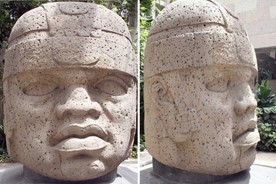
Tlatilco
The Tlatilco established their village in the Valley of Mexico, which today is Mexico City, long before the Aztecs (Mexica). Five hundred burial sites were discovered here, along with high quality pottery and ceramics.
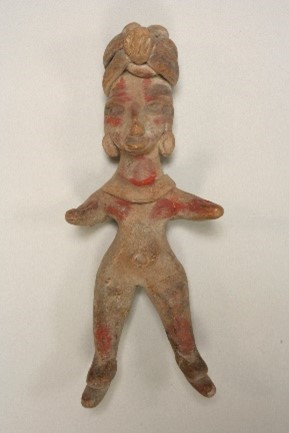
Tlatilco were known for small ceramic figures that were crafted by hand and brightly painted. Most of the figurines that have been found are female. Male figures are rare finds and usually wearing masks, as if participating in religious roles.
Tlatilco female figurine from 1200-900 BCE was a Mesoamerican funerary object. The work is very detailed, with an elaborate hairstyle and paint. With two faces and three eyes, art historians believe she represents a deity. Today the work is housed at Princeton University Art Museum.
Mayan Art
Mayan artists were elite specialists who created art objects in workshops for rulers, priests, and nobles. Some of the works were used in ceremonies, while others were commissioned as burial objects. Mayan art included ceramics and codex ceramics, woodcarvings, small sculptures, large stone sculptures, stucco modelling, mural painting, writing and bookmaking.
Murals and Mayan Art
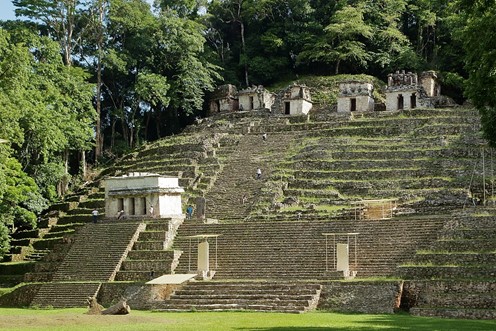
Bonampak, a Maya archaeological site, dating back to 580- 800 CE, in Chiapas, Mexico, is best known for its mural paintings. These well-preserved works, which cover the walls of three rooms illustrate court life, ceremony, and combat of Mayan culture, in detail.
Mayan Artists and Works in Stone
The jade figurine of the Deity Figure is a pre-Columbian artwork, seated in a crab claw position. This was typical of Maya sculptures in the early part of the Classic period. This may represent an anthropomorphic image of the Principal Bird Deity or a human wearing the mask of the deity. Regardless, the figure is adorned with jewelry including large earflares, a necklace, bracelet and anklet made of beads. The Bird Deity was associated with the richness within the earth, primarily jade, prized for being extremely rare and hard.
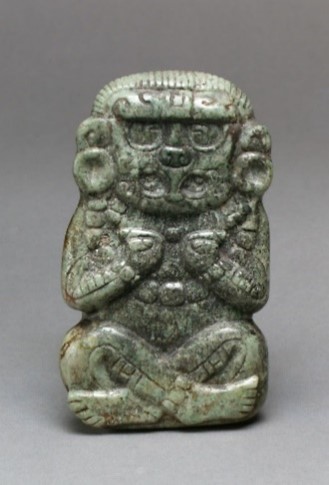
Architectural Elements in Stonework
Larger stoneworks used as architectural elements were usually crafted from limestone. These works included, stelae, lintels, panels and tablets, relief columns, altars, zoomorphs, ball court markers, monumental stairs, thrones and benches, and sculpture in the round.
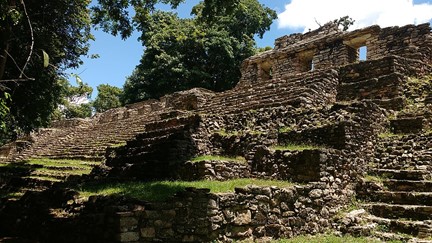
Yaxchilán is a limestone constructed, religious, social, and political complex dating back to 725 CE, in Chiapas, Mexico. Stucco decorates the exterior, while the roofs contain roof combs. Of particular importance are the stone lintels and stelae with significant historical information gained through hieroglyphic text.
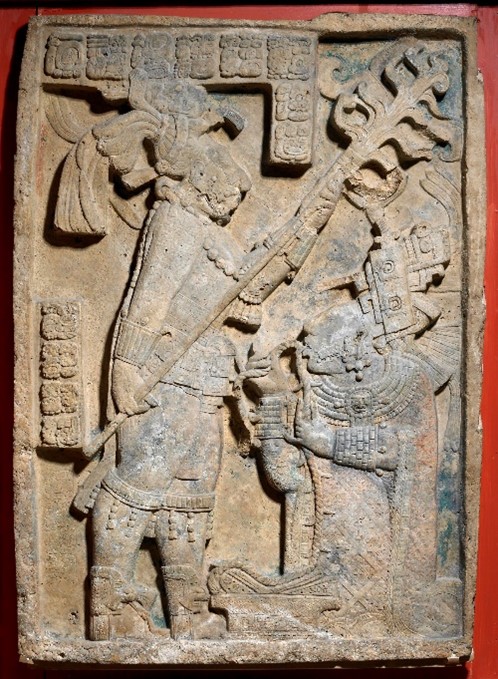
Lintel 24, at Yaxchilán is a carved and painted work in limestone illustrating Yaxchilán, Itzamnaaj Bahlam (Shield Jaguar), and his wife, Ix K’abal Xook (Lady Xook) performing a bloodletting ritual.
Copán another site of Maya Civilization lies in western Honduras and was built during the Classical period (300-900 CE). It is known for impressive stonework and numerous portrait stelae.
The core of the ancient city is the Acropolis or raised royal complex, linked to five plazas. This includes the Hieroglyphic Stairway. The famous monumental stairs are made from hewn stone blocks. Decorated with 1,800 individual glyphs, it is the longest Mayan inscription ever found, and considered an important historical find.
Just north of this structure is the Ballcourt. This is the largest one found from the Classic period and has 16 mosaic sculptures of birds.
On the west side on the Acropolis is a royal palace accessed by a monumental stairway. A bench found inside one of the structures here illustrates the King’s accession to the throne.
The Monument Plaza or Great Plaza is on the north side of the city core. At Copán, Altar Q is the most famous. It depicts the 16 kings in dynastic succession. Each sit on his name glyph, revealing a great deal about Mayan culture.
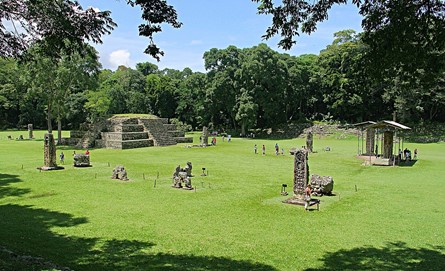
Mexica (Aztec) Art
Art in Aztec culture consisted of featherwork, codices, murals, stone, and terra cotta sculptures and mosaics.
The capital during the Aztec empire was the great city of Tenochtitlán. Now the ruins lie directly beneath Mexico City. The massive city, that is reported to have once had almost 700,000 citizens, was built on a series of inlets, on Lake Texacoco. The area was divided into four city sections. In the center was the Great Pyramid of Tenochtitlan that rose 164 feet.
The center of the city was walled off and contained the Great Temple or Templo Mayor, an Aztec religious complex built between 1375-1520 CE. Up staircases on either side, it had two shrines dedicated to gods. Human sacrifices were performed here, as religious ceremonies to honor the gods.
At the base of the stairs the giant 11 feet in diameter Coyolxauhqui Stone, created using low relief was found. The sculptural work contains images of sculls, bones, and lifeless bodies. Also found here was Calendar Stone,12 feet in diameter representing the cosmos.
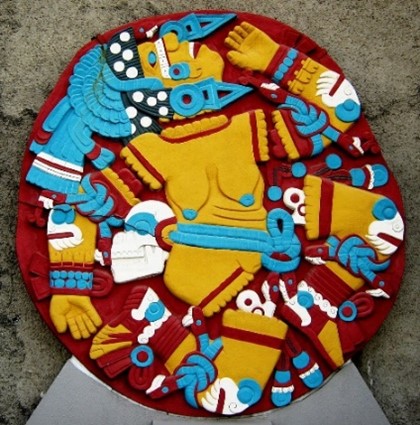
Another piece of fascinating work is the Ruler’s feather headdress from 1428- 1520 thought to have been made for Motecuhzoma II, the last Aztec King. Today the work is housed in World Museum in Vienna, Austria.
Related Art Terms
- Pre-Columbian
- Archaic period
- Pre-Classic period or Pre-Formative period
- Classic period
- Post-Columbian
- Epiclassic Period
- Post- Classic Period
- Corbelled vaulted architecture
- Colossal heads
- Codex ceramics
- Anthropomorphic
- Stelae
- Lintels
- Tablets
- Relief columns
- Altars
- Zoomorphic Art
- Ball court markers
- Monumental stairs
- Thrones
- Sculpture in the round
- Glyphs
- Featherwork
